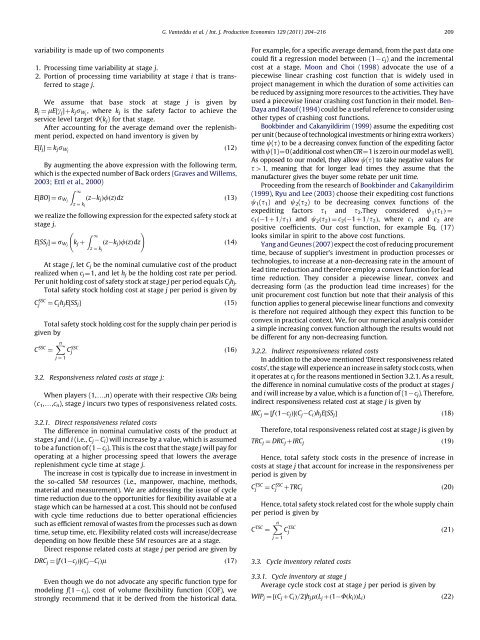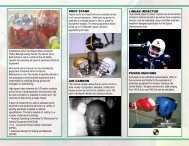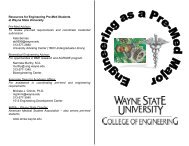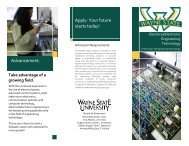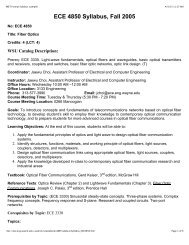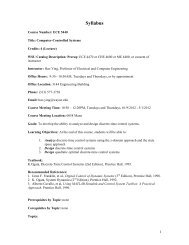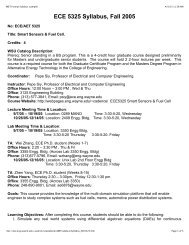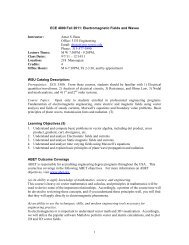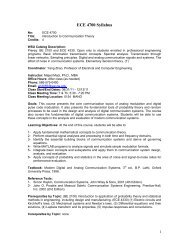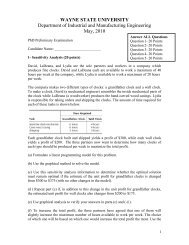Supply chain focus dependent supplier selection problem
Supply chain focus dependent supplier selection problem
Supply chain focus dependent supplier selection problem
You also want an ePaper? Increase the reach of your titles
YUMPU automatically turns print PDFs into web optimized ePapers that Google loves.
G. Vanteddu et al. / Int. J. Production Economics 129 (2011) 204–216 209variability is made up of two components1. Processing time variability at stage j.2. Portion of processing time variability at stage i that is transferredto stage j.We assume that base stock at stage j is given byB j ¼ mE½g j Šþk j s Wj , where k j is the safety factor to achieve theservice level target F(k j ) for that stage.After accounting for the average demand over the replenishmentperiod, expected on hand inventory is given byE½I j Š¼k j s Wjð12ÞBy augmenting the above expression with the following term,which is the expected number of Back orders (Graves and Willems,2003; Ettl et al., 2000)Z 1E½BOŠ¼s Wj ðzz ¼ k jk j ÞfðzÞdz ð13Þwe realize the following expression for the expected safety stock atstage j.E½SS j Š¼s Wj k j þZ 1ðzz ¼ k j!k j ÞfðzÞdzð14ÞAt stage j, let C j be the nominal cumulative cost of the productrealized when c j ¼1, and let h j be the holding cost rate per period.Per unit holding cost of safety stock at stage j per period equals C j h j .Total safety stock holding cost at stage j per period is given byCj SSC ¼ C j h j E½SS j Š ð15ÞTotal safety stock holding cost for the supply <strong>chain</strong> per period isgiven byC SSC ¼ Xnj ¼ 1C SSCj3.2. Responsiveness related costs at stage j:ð16ÞWhen players (1,y,n) operate with their respective CIRs being(c 1 ,y,c n ), stage j incurs two types of responsiveness related costs.3.2.1. Direct responsiveness related costsThe difference in nominal cumulative costs of the product atstages j and i (i.e., C j C i ) will increase by a value, which is assumedto be a function of (1 c j ). This is the cost that the stage j will pay foroperating at a higher processing speed that lowers the averagereplenishment cycle time at stage j.The increase in cost is typically due to increase in investment inthe so-called 5M resources (i.e., manpower, machine, methods,material and measurement). We are addressing the issue of cycletime reduction due to the opportunities for flexibility available at astage which can be harnessed at a cost. This should not be confusedwith cycle time reductions due to better operational efficienciessuch as efficient removal of wastes from the processes such as downtime, setup time, etc. Flexibility related costs will increase/decreasedepending on how flexible these 5M resources are at a stage.Direct response related costs at stage j per period are given byDRC j ¼½f ð1 c j ÞŠðC j C i Þm ð17ÞEven though we do not advocate any specific function type formodeling f(1 c j ), cost of volume flexibility function (COF), westrongly recommend that it be derived from the historical data.For example, for a specific average demand, from the past data onecould fit a regression model between (1 c j ) and the incrementalcost at a stage. Moon and Choi (1998) advocate the use of apiecewise linear crashing cost function that is widely used inproject management in which the duration of some activities canbe reduced by assigning more resources to the activities. They haveused a piecewise linear crashing cost function in their model. Ben-Daya and Raouf (1994) could be a useful reference to consider usingother types of crashing cost functions.Bookbinder and Cakanyildirim (1999) assume the expediting costper unit (because of technological investments or hiring extra workers)time c(t) to be a decreasing convex function of the expediting factorwith c(1)¼0 (additional cost when CIR¼1iszeroinourmodelaswell).As opposed to our model, they allow c(t) to take negative values fort41, meaning that for longer lead times they assume that themanufacturer gives the buyer some rebate per unit time.Proceeding from the research of Bookbinder and Cakanyildirim(1999), Ryu and Lee (2003) choose their expediting cost functionsc 1 (t 1 ) and c 2 (t 2 ) to be decreasing convex functions of theexpediting factors t 1 and t 2 .They considered c 1 ðt 1 Þ¼c 1 ð 1þ1=t 1 Þ and c 2 ðt 2 Þ¼c 2 ð 1þ1=t 2 Þ, where c 1 and c 2 arepositive coefficients. Our cost function, for example Eq. (17)looks similar in spirit to the above cost functions.Yang and Geunes (2007) expect the cost of reducing procurementtime, because of <strong>supplier</strong>’s investment in production processes ortechnologies, to increase at a non-decreasing rate in the amount oflead time reduction and therefore employ a convex function for leadtime reduction. They consider a piecewise linear, convex anddecreasing form (as the production lead time increases) for theunit procurement cost function but note that their analysis of thisfunction applies to general piecewise linear functions and convexityis therefore not required although they expect this function to beconvex in practical context. We, for our numerical analysis considera simple increasing convex function although the results would notbe different for any non-decreasing function.3.2.2. Indirect responsiveness related costsIn addition to the above mentioned ‘Direct responsiveness relatedcosts’, the stage will experience an increase in safety stock costs, whenit operates at c j for the reasons mentioned in Section 3.2.1. As a result,the difference in nominal cumulative costs of the product at stages jand i will increase by a value, which is a function of (1 c j ). Therefore,indirect responsiveness related cost at stage j is given byIRC j ¼½f ð1 c j ÞŠðC j C i Þh j E½SS j Š ð18ÞTherefore, total responsiveness related cost at stage j is given byTRC j ¼ DRC j þIRC jð19ÞHence, total safety stock costs in the presence of increase incosts at stage j that account for increase in the responsiveness perperiod is given byCjTSC ¼ Cj SSC þTRC j ð20ÞHence, total safety stock related cost for the whole supply <strong>chain</strong>per period is given byC TSC ¼ Xnj ¼ 1C TSCj3.3. Cycle inventory related costsð21Þ3.3.1. Cycle inventory at stage jAverage cycle stock cost at stage j per period is given byWIP j ¼½ðC j þC i Þ=2Šh j mðL j þð1 Fðk i ÞÞL i Þ ð22Þ


